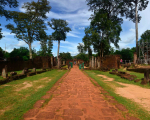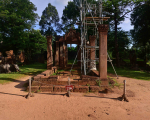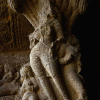The tenth century was a period of prolific Hindu temple construction in Cambodia, echoing similar projects unfolding in India and parts of Southeast Asia, such as Bali and Vietnam. Hindu temples existed in pre-Angkor Cambodia, in the older Chenla and Funan kingdoms, but they reached their apogee during the Angkor period, beginning 802 CE with the coronation of King Jayavarman II (ruled 802–835 CE) who unified the country. In the next two centuries, Angkor emerged as the pre-eminent power in mainland Southeast Asia, competing for regional hegemony with the Champa Kingdom to the east and the Sri Vijayan Empire to the south. As Angkor became powerful, monumental architectural projects were commissioned by successive emperors, and new capital cities were established at Yashodarapura, Koh Ker and Hariharalaya. By the mid-tenth century, Angkor was dotted with mega Hindu temples, including Bakong, Phnom Bakheng, Pre Rup, Lolei, Phnom Krom, Preah Ko, Phnom Bok and others.
In 944 CE, Rajendravarman II came to power at a young age. Taking advantage of a minor king who was likely under a regent, high ranking officials and Brahmin advisors secured privileges for themselves and established numerous temples on land grants secured from the royal court. One such Brahmin advisor, or guru, was Yajnavaraha. He and his younger brother, Vishnukumara, were granted permission to build a temple complex in a rural settlement located on the outskirts of the capital Yashodharapura. This settlement was named Ishawarapura, literally ‘the city of Ishwara’, one of the many names of Lord Shiva.
Here, away from the regulation of court officials, the brothers commissioned a unique temple complex dedicated to Shiva in the form of Tribhuvanamaheswara (Supreme Lord of the Three Realms, i.e. swarga, bhumi and patala). The temple complex was rediscovered by French explorers in the early twentieth century, and was given a new name, Banteay Srei.
Because the temple was patronised by a Brahmin teacher and not by Khmer royalty, Banteay Srei has features which are exceptional when compared to other Angkor temples. Most striking is its miniature scale, which might have been necessary due to various reasons. It would have been imprudent for a private temple to match the grand scale of a temple commissioned by a king, or it could be the brothers had limited resources, hence had to scale down on size. It is also possible that the smaller size was deliberate, focussing more on aesthetic excellence instead. This possibility is strengthened by the fact that the raw material used—high-grade pinkish sandstone—was valuable and rare to source. Due to its hardness, the stone used at Banteay Srei has retained sharpness and finishing, even after a millennium of exposure to sun, wind, rain, wildlife and natural erosion.
In 1936, Banteay Srei’s foundation stele was discovered, which gives 967 CE as year of foundation. The early date of the temple’s foundation has perplexed archaeologists. The exceptional quality of the carvings and also the presence of advanced visual narratives did not develop for another two hundred years at Angkor, culminating in the great bas-reliefs of Angkor Wat and Bayon. The reason behind this anachronism might be explained in the inscriptions found, which not only eulogise kings for sponsoring construction of new temples but also mention renovations, enlargements and endowments made to older temples. It is possible that Banteay Srei was built upon by later patrons, and the final form of the temple—and its complex artwork— was not achieved till several centuries later. Art historian Vittorio Roveda has suggested that Banteay Srei was periodically modified till the fourteenth century. The original temple was a simple brick structure, parts of which still survive. Other than the foundation stele, inscriptions have been found dating from 1011, the period of Suryavarman I, and 1304, during the reign of Shrindravarman I. Inscriptions in other monuments, like Phnom Sandak and Preah Vihear, mention Suryavarman II (builder of Angkor Wat) sending his guru, Pandit Dibakar, to Banteay Srei to restore the temple and re-establish Shaivite practices initiated by Rajendravarman’s successor, Jayavarman V. Inscriptions also mention that Yajnavaraha continued in his exalted role as ‘Vrah Guru’ and trained Jayavarman V.
Banteay Srei’s innermost enclosure is surrounded by a moat and has three central shrines; two dedicated to Shiva and one to Vishnu. The temple also has wide representation of beasts, apsaras, devatas, gandharvas, gods and goddesses of the Hindu pantheon. These narratives cover stories from the Mahabharat and the Ramayana, Shaktism and dashavatara (ten avatars of Vishnu). The artwork of Banteay Srei is not just an act of hired craftsmanship. From the density of the carvings, it would seem artists were given license to decorate every available surface in a competitive expression of devotion to Hindu Dharma. As a result, Banteay Srei’s exuberant artwork marks the acme of Hindu temple art, unmatched at Angkor.
The last inscription at Banteay Srei dates back to 1303, after which the temple probably lost patronage when Hinduism declined throughout Angkor and was replaced by Theravada Buddhism in the fourteenth century.
Lost to forests for five centuries, Banteay Srei was rediscovered in 1914, but the temple was left unguarded for more than a decade when it suffered much desecration and looting at the hands of treasure hunters who plundered the site under the guise of archaeology work. For example, the novelist Georges AndréMalraux, who was France’s first Minister of Culture under the Charles de Gaulle presidency (1959–69), illegally removed four apsaras in 1923. He was immediately caught and the pieces recovered. Many sculptures were successfully smuggled out and are now displayed in European museums like the Guimet Museum in Paris.
To protect the temple, the forest around Banteay Srei was cleared, and restoration of the site started in 1931, with work assigned to French archaeologist Henri Marchal. Marchal was inspired by the new anastylosis method applied by Dutch archaeologists in Java, and he successfully undertook anastylosis at Banteay Srei. In this process, a ruined monument is restored using original architectural elements to the greatest degree possible with addition of new materials as required for structural integrity. After a century of its rediscovery, Banteay Srei has been restored close to how it would have looked in the Angkor period.
Banteay Srei is one of the most visited sites in Angkor, which was designated a World Heritage Site by UNESCO in 1992. Increasing tourism has put the temple at great risk of vandalism, and visitors are not allowed entry to the innermost enclosure. The high demand for Angkor’s antiquities in the international black market and amongst art collectors is another looming threat. Even now, under constant supervision of APSARA authorities, Banteay Srei is relentlessly targeted by armed gangs. To prevent looting, original guardian figures of Hanuman and Garuda were removed from the site and replaced by concrete replicas. Although the replicas were vandalised too! This shows the desperation of criminals and the uphill task faced by authorities to protect the ‘Jewel of Khmer Art’.
Bibliography
Coedes, George. The Indianized States of South East Asia. Edited by Walter F. Vella and translated by Susan Brown Cowing. Honolulu: East-West Center Press,1968.
Petrotchenko, Michel. Focusing on the Angkor Temples: The Guidebook. Thailand: Amarin, 2012.
Roveda, Vittorio. Images of Gods: Khmer Mythology in Cambodia, Thailand and Laos. Bangkok Warren, C.T. Easthampton, M.A: Published and distributed in Thailand by River Books Floating World Editions Distributed by ACC Distribution, 2005.
















